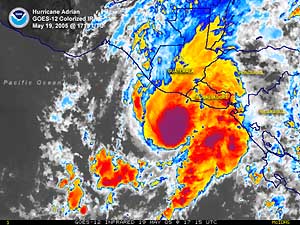Pacific Basin
The eastern North Pacific hurricane season officially begins on May 15th, generally peaks in late August/early September and concludes around the end of November. One system was active in May in 2005, becoming a hurricane. On May 17th, Tropical Storm Adrian formed from a tropical wave that had crossed Central America, entering the eastern Pacific on the 15th. The storm had become a tropical depression earlier the same day and quickly strengthened to tropical storm force. Unusually for the East Pacific, Adrian began to track north-northeastward with windspeeds further increasing to reach hurricane strength on the 19th about 120 miles southwest of El Salvador. Adrian abruptly weakened offshore before making landfall, though heavy rain led to flooding and mudslides in El Salvador.
Statistically, a hurricane occurs in the East Pacific in May approximately once every four years.Accumulated Cyclone Energy (ACE) indices are available for Adrian.
 NOAA's National Centers for Environmental Information
NOAA's National Centers for Environmental Information
